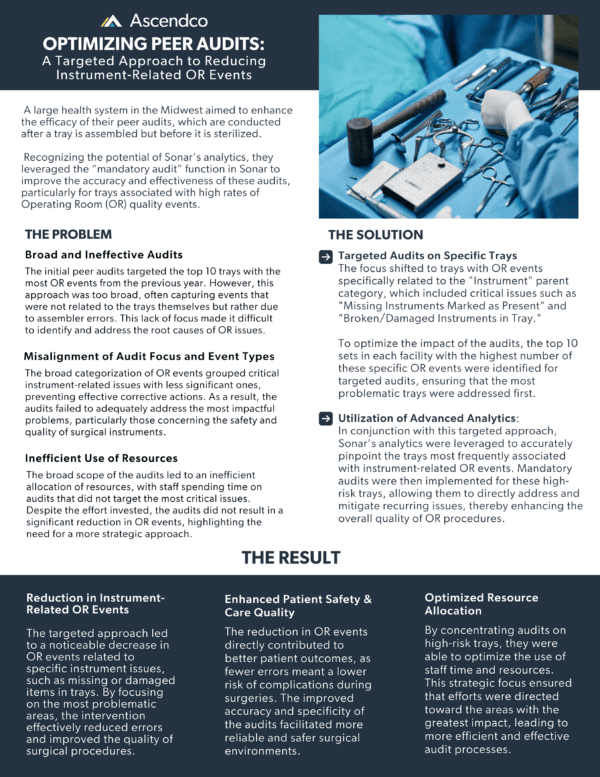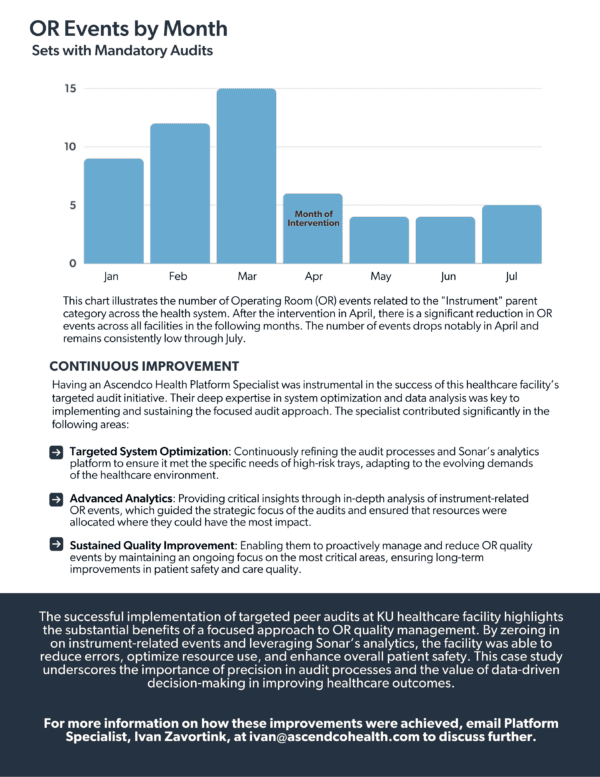This case study highlights a large health system in the Midwest’s commitment to patient safety through a novel approach to peer audits. By focusing on instrument-related events and leveraging data analytics, the health system achieved impressive results.
The Challenge
Previously, peer audits were broad, encompassing all OR trays regardless of instrument content. This led to inefficiencies, as many trays weren’t relevant to potential issues under investigation. Additionally, the lack of focus on instrument issues hindered identifying and addressing error root causes.
The Solution
To improve audit effectiveness, the health system implemented a targeted approach focusing solely on trays related to “instrument events,” including critical issues like broken/damaged or missing instruments. This narrowed scope allowed for more efficient resource allocation and effective targeting of the most pressing concerns.
The Results
The targeted approach yielded significant improvements:
- Reduced Instrument-Related OR Events: By focusing on high-risk trays, the health system implemented targeted interventions to prevent these errors.
- Enhanced Patient Safety & Care Quality: The reduction in instrument-related errors contributed to improved patient outcomes, with fewer complications due to surgical errors.
- Optimized Resource Allocation: Concentrating audits on high-risk trays facilitated more efficient resource allocation, ensuring staff time and expertise were directed towards critical areas.
The Role of Ascendco Health Platform Specialists
The invaluable contributions of the Ascendco Health Platform Specialist played a key role in the initiative’s success. Their expertise in system optimization, data analysis, and quality improvement were crucial:
- Targeted System Optimization: Continuously refining audit processes and the analytics platform to align with the specific needs of high-risk trays, adapting to the evolving healthcare environment.
- Advanced Analytics: Leveraging data analytics to gain deep insights into instrument-related OR events, guiding the strategic focus of the audits and ensuring resources were allocated for maximum impact.
- Sustained Quality Improvement: Maintaining an ongoing focus on the most critical areas to ensure long-term improvements in patient safety and care quality.
Conclusion
This large health system’s targeted peer audit initiative exemplifies a model for other healthcare organizations seeking to enhance patient safety and improve overall care quality. Through prioritization of precision, data-driven decision-making, and a continuous focus on improvement, they demonstrated the power of targeted interventions in reducing errors, optimizing resource use, and ultimately, enhancing patient outcomes.
For more information, please contact Platform Specialist, Ivan Zavortink, at ivan@ascendcohealth.com.

